Maytag MLE26PRBYW, MLG26PRKWW, MLG26PDBWW, MLE26PDBYW Installation Manual
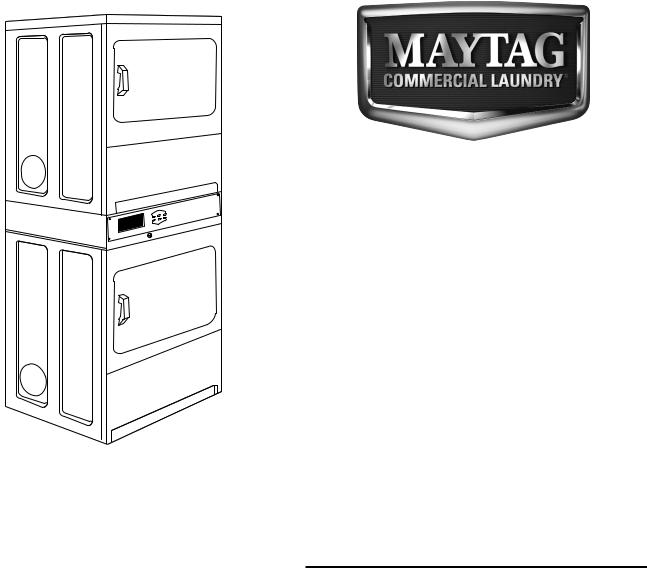
TABLE OF CONTENTS
. |
Page |
Dryer Safety.......................................................................................................... |
2 |
Tools & Parts ....................................................................................................... |
5 |
Dimensions/Clearances .............................................................................. |
6 |
Location Requirements ................................................................................ |
7 |
Gas Dryer Electrical Requirements ....................................................... |
8 |
Gas Requirements .......................................................................................... |
9 |
Electric Dryer Electrical Requirements ............................................. |
10 |
Dryer Venting Requirements .................................................................. |
13 |
Gas Supply Connection ............................................................................ |
15 |
Electric Dryer Electrical Connections ................................................ |
17 |
Leveling ............................................................................................................... |
21 |
Complete Installation .................................................................................. |
22 |
Reversing Dryer Door Swing ................................................................... |
23 |
Maintenance Instructions .......................................................................... |
24 |
If You Need Assistance .............................................................................. |
24 |
Electronic Control Setup Instructions ................................................ |
25 |
Warranty ............................................................................................................. |
30 |
W10761033B
W10761034B-SP
INSTALLATION
INSTRUCTIONS
Commercial Stacked Dryer Gas (120-Volt, 60-Hz)
or Electric (120/240-Volt, 60-Hz)
INSTRUCTIONS
D’INSTALLATION
Sécheuse à usage commercial superposée à gaz (120 Volts, 60 Hz) ou électrique (120/240 Volts, 60 Hz)
TABLE DES MATIÈRES
. |
Page |
Sécurité de la sécheuse............................................................................ |
31 |
Outils et pièces ............................................................................................. |
34 |
Dimensions/Distances de dégagement .......................................... |
35 |
Exigences de l’emplacement.................................................................. |
36 |
Exigences électriques pour la sécheuse à gaz.............................. |
37 |
Exigences de gaz.......................................................................................... |
38 |
Exigences électriques pour la sécheuse électrique ................ |
39 |
Exigences concernant l’évacuation de la sécheuse ................. |
40 |
Raccordement à la canalisation de gaz ............................................ |
42 |
Nivellement ........................................................................................................ |
44 |
Achever l’installation .................................................................................... |
45 |
Inversion du sens d’ouverture de la porte ........................................ |
46 |
Instructions d’entretien ............................................................................... |
47 |
Si vous avez besoin d’assistance ......................................................... |
47 |
Instructions de réglage du tableau |
|
de commande électronique ...................................................................... |
48 |
Garantie ............................................................................................................. |
55 |
www.maytagcommerciallaundry.com
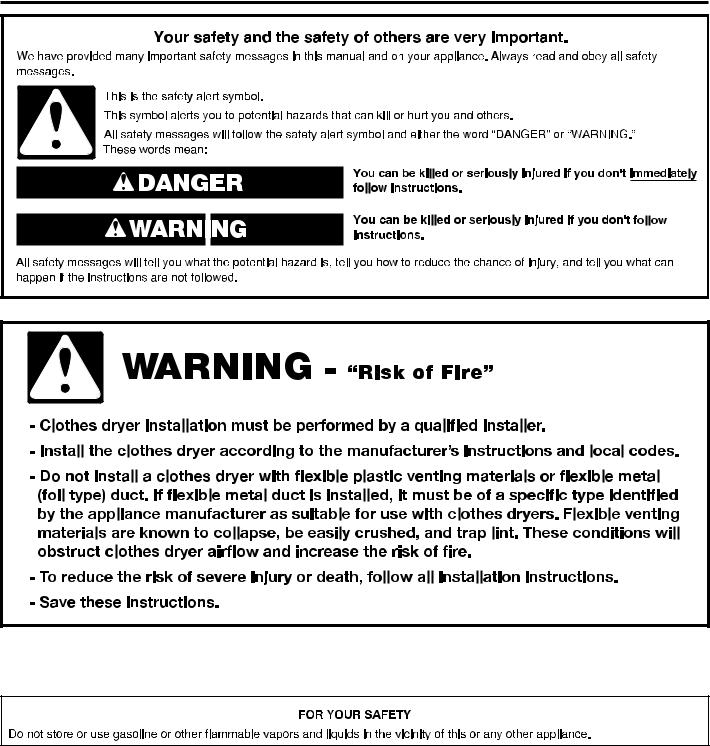
DRYER SAFETY
■■ It is recommended that the owner post, in a prominent location, instructions for the customer’s use in the event the customer smells gas. This information should be obtained from your gas supplier.
■■ Post the following warning in a prominent location.
2
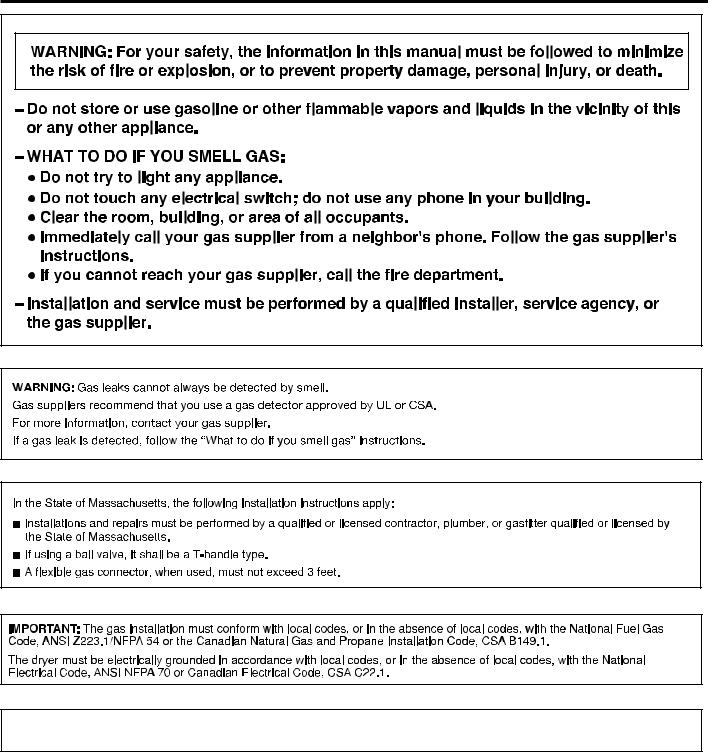
DRYER SAFETY
IMPORTANT: When discarding or storing your old clothes dryer, remove the door.
3

DRYER SAFETY
IMPORTANT SAFETY INSTRUCTIONS
WARNING: To reduce the risk of fire, electric shock, or injury to persons when using the dryer, follow basic precautions, including the following:
■■ Read all instructions before using the dryer.
■■ This dryer is intended only for drying clothes and textiles that have been washed in water. Do not use for any other purpose.
■■ WARNING: If you smell gas, do not use the dryer or any electrical equipment nearby. Warn other people to clear the area. Contact the dryer owner immediately.
■■ Do not place items exposed to cooking oils in your dryer. Items contaminated with cooking oils may contribute to a chemical reaction that could cause a load to catch fire.
■■ Do not dry articles that have been previously cleaned in, washed in, soaked in, or spotted with gasoline, dry-cleaning solvents, other flammable, or explosive substances as they give off vapors that could ignite or explode.
■■ Do not dry unwashed items in the dryer.
■■ Do not allow children to play on or in the dryer. Close supervision of children is necessary when the dryer is used near children.
■■ Before the dryer is removed from service or discarded, remove the doors to the dryer compartment.
■■ Do not reach into the dryer if the drum is moving.
■■ Do not open door while dryer is in operation. It will stop.
■■ Do not install or store the dryer where it will be exposed to water and/or the weather.
■■ Do not tamper with controls.
■■ Clean dryer lint screen before or after each load.
■■ Do not use this dryer without the lint screen in place.
■■ Do not repair or replace any part of the dryer or attempt any servicing unless specifically recommended in this Installation Instructions or in published user-repair instructions that you understand and have the skills to carry out.
■■ Do not use fabric softeners or products to eliminate static unless recommended by the manufacturer of the fabric softener or product.
■■ Do not use heat to dry articles containing foam rubber or similarly textured rubber-like materials.
■■ The final part of a tumble dryer cycle occurs without heat (cool-down cycle) to ensure that the articles are left at a temperature that ensures that the items will not be damaged.
■■ WARNING: Never stop a tumble dryer before the end of the drying cycle unless all items are quickly removed and spread out so that the heat is dissipated. (Avoids risk of spontaneous combustion).
■■ Keep area around the exhaust opening and adjacent surrounding areas free from the accumulation of lint, dust, and dirt.
■■ The interior of the dryer and dryer exhaust vent should be cleaned periodically by qualified service personnel.
■■ See “Electrical Requirements” section for grounding instructions.
SAVE THESE INSTRUCTIONS
4

TOOLS & PARTS
Tools Needed:
8" (200 mm) |
8" (200 mm) or 10" (250 mm) |
Flat-blade screwdriver |
Phillips screwdriver |
or 10" (250 mm) |
Adjustable wrench |
|
|
Pipe wrench |
that opens to 1" (25 mm) |
|
|
Torx T-20®† security |
1" (25 mm) Hex-head |
5⁄16" (8 mm) Socket wrench |
Pliers (that open to |
screwdriver or bit |
socket wrench |
|
19/16" [39 mm]) |
Level |
Utility knife |
1/4" (6 mm) Nut driver |
27" (686 mm) |
|
|
|
Wood block |
Caulk gun and caulk |
Vent clamps |
Pipe-joint compound |
Putty knife |
(for installing new exhaust vent) |
|
suitable for gas type |
|
Flashlight (optional) |
1" (25 mm) |
Ruler or measuring tape |
|
Open-end wrenches |
|
Parts Supplied:
Security cotter pins (2)
†® TORX and T-20 are registered trademarks of Acument Intellectual Properties, LLC.
5
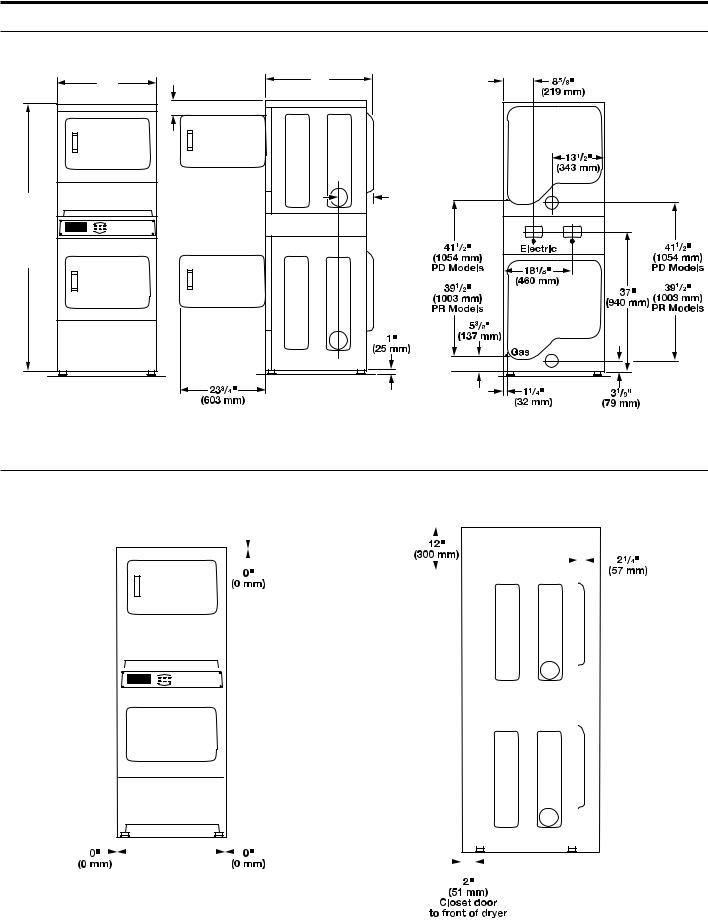
DIMENSIONS/CLEARANCES
Dimensions
Front View |
Side View |
Back View |
27" |
(686 mm) |
763/4" |
(1950 mm) |
PD Models |
741/4" |
(1886 mm) |
PR Models |
5" |
29" |
(127 mm) |
(737 mm) |
10 |
1 |
/2" |
|
(267 mm) |
|
Minimum Clearances
Front View, Recessed Opening |
|
|
|
Side View, Recessed In Closet |
||||||||||||||||||||||||||||||||
|
|
|
|
|
|
|
|
|
|
|
|
|
|
|
|
|
|
|
|
|
|
|
|
|
|
|
|
|
|
|
|
|
|
|
|
|
|
|
|
|
|
|
|
|
|
|
|
|
|
|
|
|
|
|
|
|
|
|
|
|
|
|
|
|
|
|
|
|
|
|
|
|
|
|
|
|
|
|
|
|
|
|
|
|
|
|
|
|
|
|
|
|
|
|
|
|
|
|
|
|
|
|
|
|
|
|
|
|
|
|
|
|
|
|
|
|
|
|
|
|
|
|
|
|
|
|
|
|
|
|
|
|
|
|
|
|
|
|
|
|
|
|
|
|
|
|
|
|
|
|
|
|
|
|
|
|
|
|
|
|
|
|
|
|
|
|
|
|
|
|
|
|
|
|
|
|
|
|
|
|
|
|
|
|
|
|
|
|
|
|
|
|
|
|
|
|
|
|
|
|
|
|
|
|
|
|
|
|
|
|
|
|
|
|
|
|
|
|
|
|
|
|
|
|
|
|
|
|
|
|
|
|
|
|
|
|
|
|
|
|
|
|
|
|
|
|
|
|
|
|
|
|
|
|
|
|
|
|
|
|
|
|
|
|
|
|
|
|
|
|
|
|
|
|
|
|
|
|
|
|
|
|
|
|
|
|
|
|
|
|
|
|
|
|
|
|
|
|
|
|
|
|
|
|
|
|
|
|
|
|
|
|
|
|
|
|
|
|
|
|
|
|
|
|
|
|
|
|
|
|
|
|
|
|
|
|
|
|
|
|
|
|
|
|
|
|
|
|
|
|
|
|
|
|
|
|
|
|
|
|
|
|
|
|
|
|
|
|
|
|
|
|
|
|
|
|
|
|
|
|
|
|
|
|
|
|
|
|
|
|
|
|
|
|
|
|
|
|
|
|
|
|
|
|
|
|
|
|
|
|
|
|
|
|
|
|
|
|
|
|
|
|
|
|
|
|
|
|
|
|
|
|
|
|
|
|
|
|
|
|
|
|
|
|
|
|
|
|
|
|
|
|
|
|
|
|
|
|
|
|
|
|
|
|
|
|
|
|
|
|
|
|
|
|
|
|
|
|
|
|
|
|
|
|
|
|
|
|
|
|
|
|
|
|
|
|
|
|
|
|
|
|
|
|
|
|
|
|
|
|
|
|
|
|
|
|
|
|
|
|
|
|
|
|
|
|
|
|
|
|
|
|
|
|
|
|
|
|
|
|
|
|
|
|
|
|
|
|
|
|
|
|
|
|
|
|
|
|
|
|
|
|
|
|
|
|
|
|
|
|
|
|
|
|
|
|
|
|
|
|
|
|
|
|
|
|
|
|
|
|
|
|
|
|
|
|
|
|
|
|
|
|
|
|
|
|
|
|
|
|
|
|
|
|
|
|
|
|
|
|
|
|
|
|
|
|
|
|
|
|
|
|
|
|
|
|
|
|
|
|
|
|
|
|
|
|
|
|
|
|
|
|
|
|
|
|
|
|
|
|
|
|
|
|
|
|
|
|
|
|
|
|
|
|
|
|
|
|
|
|
|
|
|
|
|
|
|
|
|
|
|
|
|
|
|
|
|
|
|
|
|
|
|
|
|
|
|
|
|
|
|
|
|
|
|
|
|
|
|
|
|
|
|
|
|
|
|
|
|
|
|
|
|
|
|
|
|
|
|
|
|
|
|
|
|
|
|
|
|
|
|
|
|
|
|
|
|
|
|
|
|
|
|
|
|
|
|
|
|
|
|
|
|
|
|
|
|
|
|
|
|
|
|
|
|
|
|
|
|
|
|
|
|
|
|
|
|
|
|
|
|
|
|
|
|
|
|
|
|
|
|
|
|
|
|
|
|
|
|
|
|
|
|
|
|
|
|
|
|
|
|
|
|
|
|
|
|
|
|
|
|
|
|
|
|
|
|
|
|
|
|
|
|
|
|
|
|
|
|
|
|
|
|
|
|
|
|
|
|
|
|
|
|
|
|
|
|
|
|
|
|
|
|
|
|
|
|
|
|
|
|
|
|
|
|
|
|
|
|
|
|
|
|
|
|
|
|
|
|
|
|
|
|
|
|
|
|
|
|
|
|
|
|
|
|
|
|
|
|
|
|
|
|
|
|
|
|
|
|
|
|
|
|
|
|
|
|
|
|
|
|
|
|
|
|
|
|
|
|
|
|
|
|
|
|
|
|
|
|
|
|
|
|
|
|
|
|
|
|
|
|
|
|
|
|
|
|
|
|
|
|
|
|
|
|
|
|
|
6

LOCATION REQUIREMENTS
Your dryer can be installed in a basement, laundry room, or recessed area.
This dryer is not intended for installation in a mobile home.
Companion appliance location requirements should also be considered.
IMPORTANT:
■■ Do not install or store the dryer where it will be exposed to water and/or the weather. Proper installation is your responsibility.
■■ This dryer must not be installed in a closet with a door.
You will need:
■■ A grounded electrical outlet located within 6 ft. (1.8 m) of where the power cord is attached to the back of the dryer. See “Electrical Requirements.”
■■ A level floor with a maximum slope of 1" (25 mm) under entire dryer. Installing the dryer on soft floor surfaces, such as carpets or surfaces with foam backing, is not recommended.
Dryer installation clearances
■■ The location must be large enough to allow the dryer door to be fully opened.
■■ Additional spacing should be considered for ease of installation and servicing. The door opens more than 180°.
■■ Additional clearances might be required for wall, door, and floor moldings.
■■ Additional spacing of 1" (25 mm) on all sides of the dryer is recommended to reduce noise transfer.
When installing a gas dryer:
IMPORTANT: Observe all governing codes and ordinances.
■■ Check code requirements: Some codes limit or do not permit installation of clothes dryers in garages, closets, or sleeping quarters. Contact your local building inspector.
■■ Make sure that lower edges of the cabinet, plus the back and bottom sides of the dryer, are free of obstructions to permit adequate clearance of air openings for combustion air. See “Recessed Area Installation Instructions” below for minimum spacing requirements.
Recessed Area Installation Instructions
This dryer may be installed in a recessed area. For recessed area installations, minimum clearances can be found on the warning label on the rear of the dryer or in “Dimensions/Clearances.”
The installation spacing is in inches and is the minimum allowable. Additional spacing should be considered for ease of installation, servicing, and compliance with local codes and ordinances.
The dryer must be exhausted outdoors.
7

GAS DRYER ELECTRICAL REQUIREMENTS
Gas Dryer Grounding
IMPORTANT: The dryer must be electrically grounded in accordance with local codes and ordinances or, in the absence of local codes, with the National Electrical Code, ANSI/NFPA 70, latest edition, or Canadian Electrical Code, CSA C22.1. If codes permit and a separate ground wire is used, it is recommended that a qualified electrical installer determine that the ground path is adequate.
A copy of the above code standards can be obtained from:
National Fire Protection Association
One Batterymarch Park, Quincy, MA 02269
CSA International
8501 East Pleasant Valley Road
Cleveland, Ohio 44131-5575 ■■ Do not ground to a gas pipe.
■■ Do not have a fuse in the neutral or ground circuit.
■■ A 120 volt, 60 Hz, AC only, 15or 20-amp, fused electrical circuit is required. A time-delay fuse or circuit breaker is also recommended. It is recommended that a separate circuit serving only this dryer be provided.
■■ If codes permit and a separate ground wire is used, it is recommended that a qualified electrician determine that the ground path is adequate.
■■ Check with a qualified electrician if you are not sure the dryer is properly grounded.
8

GAS REQUIREMENTS
Gas Supply
IMPORTANT: Observe all governing codes and ordinances.
This installation must conform with all local codes and ordinances. In the absence of local codes, installation must conform with American National Standard, National Fuel Gas Code ANSI Z223.1/NFPA 54 or CAN/CSA B149.
A copy of the above code standards can be obtained from:
National Fire Protection Association
One Batterymarch Park, Quincy, MA 02269
CSA International
8501 East Pleasant Valley Road
Cleveland, Ohio 44131-5575
The design of this dryer has been certified by CSA International for use at altitudes up to 10,000 feet (3048 m) above sea level at the B.T.U. rating indicated on the model/serial plate. Burner input adjustments are not required when the dryer is operated up to this elevation.
When installed above 10,000 feet (3048 m), a four percent (4%) reduction of the burner B.T.U. rating shown on the model/serial plate is required for each 1,000 foot (305 m) increase in elevation. For assistance when converting to other gas types and/or installing above 10,000 feet (3048 m) elevation, contact your local service company.
9

ELECTRIC DRYER ELECTRICAL REQUIREMENTS (U.S.A. ONLY)
It is your responsibility: |
Electric Dryer Grounding |
||||||
■■ |
To contact a qualified electrical installer. |
|
|
|
|
|
|
|
|
|
|
|
|
||
■■ |
To be sure that the electrical connection is adequate and in |
|
|
|
|
|
|
|
|
|
|
|
|
||
|
conformance with the National Electrical Code, ANSI/NFPA |
|
|
|
|
|
|
|
70-latest edition and all local codes and ordinances. |
|
|
|
|
|
|
|
|
|
|
|
|
|
|
■■ The National Electrical Code requires a 4-wire power supply connection for homes built after 1996, dryer circuits involved in remodeling after 1996, and all mobile home installations.
■■ A copy of the above code standards can be obtained from: National Fire Protection Association, One Batterymarch Park, Quincy, MA 02269.
■■ To supply the required 3 or 4 wire, single phase, 120/240 volt, 60 Hz., AC only electrical supply (or 3 or 4 wire, 120/208 volt electrical supply, if specified on the serial/rating plate) on a separate 30-amp circuit, fused on both sides of the line. A time delay fuse or circuit breaker is recommended. Connect to an individual branch circuit. Do not have a fuse in the neutral or grounding circuit.
■■ Do not use an extension cord.
■■ If codes permit and a separate ground wire is used, it is recommended that a qualified electrician determine that the ground path is adequate.
Electrical Connection
To properly install your dryer, you must determine the type of electrical connection you will be using and follow the instructions provided for it here.
■■ This dryer is manufactured ready to install with a 3-wire electrical supply connection. The neutral ground conductor is permanently connected to the neutral conductor (white wire) within the dryer. If the dryer is installed with a 4-wire electrical supply connection, the neutral ground conductor must be removed from the external ground connector (green screw), and secured under the neutral terminal (center or white wire) of the terminal block. When the neutral ground conductor is secured under the neutral terminal (center or white wire) of the terminal block, the dryer cabinet is isolated from the neutral conductor.
■■ If local codes do not permit the connection of a neutral ground wire to the neutral wire, see “Optional 3-wire connection” section.
■■ A 4-wire power supply connection must be used when the appliance is installed in a location where grounding through the neutral conductor is prohibited. Grounding through the neutral is prohibited for (1) new branch-circuit installations and (2) areas where local codes prohibit grounding through the neutral conductor.
10

ELECTRIC DRYER ELECTRICAL REQUIREMENTS (U.S.A. ONLY)
Electric Dryer Power Supply Cord
Direct Wire
If using a power supply cord:
Use a UL listed power supply cord kit marked for use with clothes dryers. The kit should contain:
■■ A UL listed 30-amp power supply cord, rated 120/240 volt minimum. The cord should be type SRD or SRDT and be at least 4 ft. (1.22 m) long. The wires that connect to the dryer must end in ring terminals or “U” shaped spade terminals with upturned ends.
■■ A UL listed strain relief.
If your outlet looks like this:
|
|
|
|
|
Then choose a 4-wire power supply cord with ring or |
|
|
|
|
|
spade terminals and UL listed strain relief. The 4-wire |
|
|
|
|
|
power supply cord, at least 4 ft. (1.22 m) long, must |
|
|
|
|
|
have four 10-gauge copper wires and match a 4-wire |
|
|
|
|
|
|
|
|
|
|
|
receptacle of NEMA Type 14-30R. The ground wire |
|
4-wire |
(ground conductor) may be either green or bare. The |
|||
|
neutral conductor must be identified by a white cover. |
||||
receptacle |
|||||
(14-30R) |
|
||||
If your outlet looks like this:
Then choose a 3-wire power supply cord with ring or spade terminals and UL listed strain relief. The
3-wire power supply cord, at least 4 ft. (1.22 m) long, must have three 10-gauge copper wires and match a 3-wire receptacle of NEMA Type 10-30R.
3-wire receptacle (10-30R)
If connecting by direct wire:
Direct wire cable must match power supply (4-wire or 3-wire) and be:
■■ Flexible armored cable or nonmetallic sheathed copper cable (with ground wire), covered with flexible metallic conduit.
All current-carrying wires must be insulated.
■■ 10-gauge solid copper wire (do not use aluminum). ■■ At least 5 ft. (1.52 m) long.
11
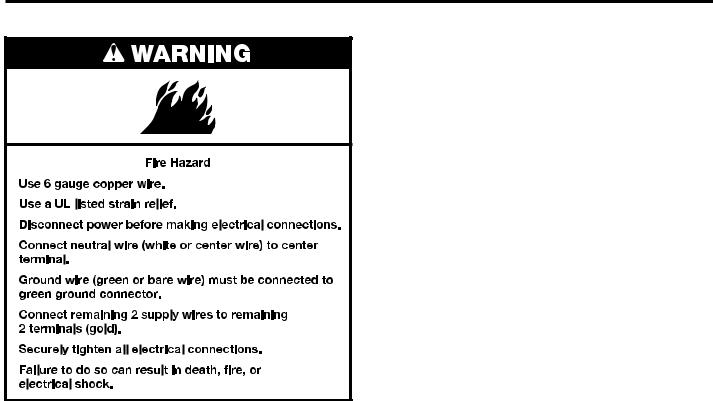
ELECTRIC DRYER ELECTRICAL REQUIREMENTS (CANADA ONLY)
Direct Wire
If connecting by direct wire:
Direct wire cable must match power supply (4-wire or 3-wire) and be:
■■ Cable must be rated to 60 Amps minimum.
■■ Flexible armored cable or nonmetallic sheathed copper cable (with ground wire), covered with flexible metallic conduit.
All current-carrying wires must be insulated.
■■ 6-gauge minimum solid copper wire (do not use aluminum). ■■ At least 5 ft. (1.52 m) long.
12
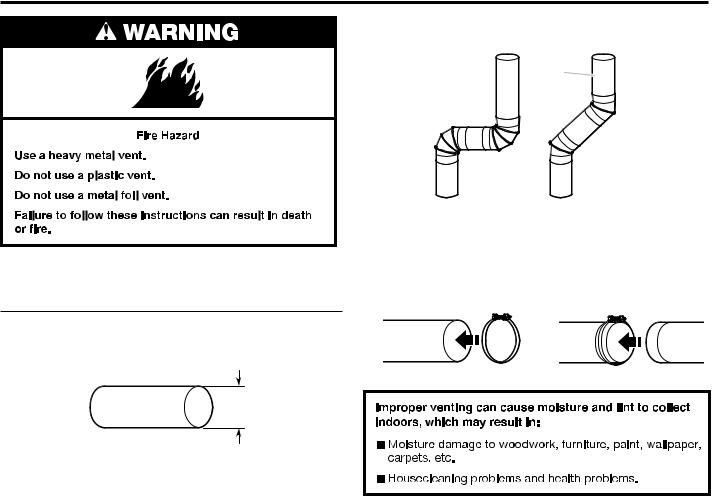
DRYER VENTING REQUIREMENTS
WARNING: To reduce the risk of fire, this dryer MUST BE EXHAUSTED OUTDOORS.
IMPORTANT: Observe all governing codes and ordinances.
Dryer exhaust must not be connected into any gas vent, chimney, wall, ceiling, attic, crawlspace, or a concealed space of a building. Only rigid or flexible metal vent shall be used for exhausting.
4" (102 mm)
4" (102 mm) Heavy, metal exhaust vent
■■ Only a 4" (102 mm) heavy, metal exhaust vent and clamps may be used.
■■ Do not use plastic or metal foil vent.
Rigid metal vent:
■■ Recommended for best drying performance and to avoid crushing and kinking.
Flexible metal vent: (Acceptable only if accessible to clean) ■■ Must be fully extended and supported in final dryer location.
■■ Remove excess to avoid sagging and kinking that may result in reduced airflow and poor performance.
■■ Do not install in enclosed walls, ceilings, or floors. ■■ The total length should not exceed 73⁄4 ft. (2.4 m).
NOTE: If using an existing vent system, clean lint from entire length of the system and make sure exhaust hood is not plugged with lint. Replace plastic or metal foil vents with rigid metal or flexible metal vents. Review “Vent System Chart” and if necessary, modify existing vent system to achieve best drying performance.
Elbows:
■■ 45° elbows provide better airflow than 90° elbows.
Good Better
Better
Clamps:
■■ Use clamps to seal all joints.
■■ Exhaust vent must not be connected or secured with screws or other fastening devices that extend into interior of duct and catch lint. Do not use duct tape.
13
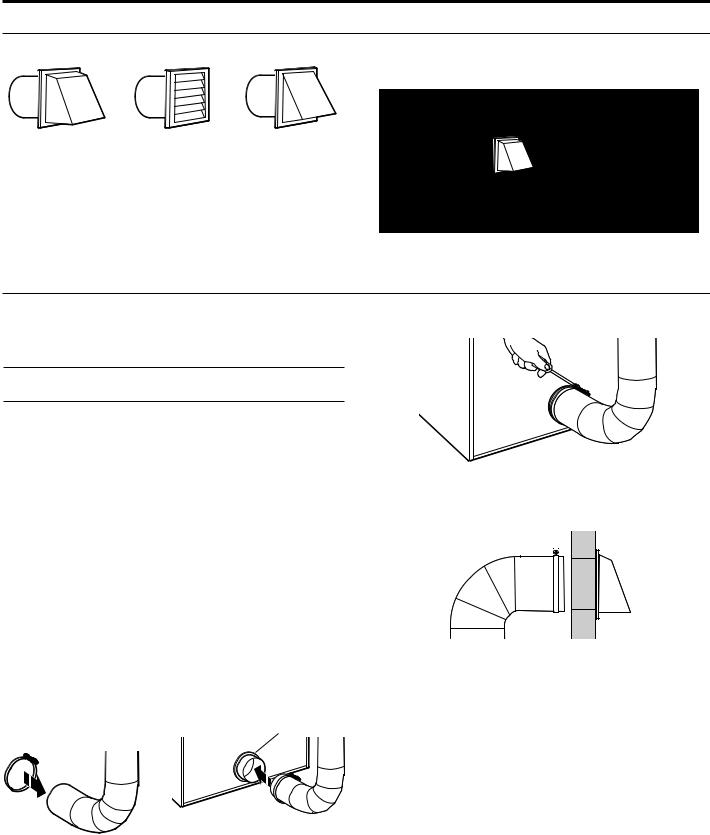
DRYER VENTING REQUIREMENTS
Vent Hoods
4" (102 mm) Diameter Exhaust Hoods |
Exhaust hood must be at least 12" (305 mm) from the ground or |
|
any object that may be in the path of the exhaust (such as flowers, |
|
rocks, bushes, or snow). |
Box hood |
Louvered hood |
Angled hood |
|
|
|
12" min. |
|
|
|
(305 mm) |
Vent System Length |
|
|
|
Maximum Vent Length/Vent Connection |
|
|
|
Maximum length of vent system depends upon the type of vent |
3. Tighten hose clamp with Phillips screwdriver. |
||
used, number of elbows, and type of exhaust hood. |
|
||
Vent System Chart (Rigid Metal Vent) |
|
||
|
Box and |
|
|
No. of 90˚ Turns |
Louvered Hood |
Angled Hood |
|
0 |
64 ft. (19.5 m) |
58 ft. (17.7 m) |
|
1 |
54 ft. (16.5 m) |
48 ft. (14.6 m) |
|
2 |
44 ft. (13.4 m) |
38 ft. (11.6 m) |
|
3 |
35 ft. (10.7 m) |
29 ft. (8.8 m) |
4 |
27 ft. (8.2 m) |
21 ft. (6.4 m) |
For vent systems not covered by the vent specification chart, see your parts distributor.
Provision must be made for enough air for combustion and ventilation. (Check governing codes and ordinances.) See “Recessed Area Installation Instructions” in the “Location Requirements” sections.
A 4" (102 mm) outlet hood is preferred. However, a 21⁄2" (64 mm) outlet exhaust hood may be used. A 21⁄2" (64 mm) outlet creates greater back pressure than other hood types. For permanent installation, a stationary vent system is required.
Connect Vent
1.If connecting to existing vent, make sure the vent is clean.
2.Using a 4" (102 mm) clamp, connect vent to exhaust outlet
in dryer.
4.Make sure the vent is secured to exhaust hood with a 4" (102 mm) clamp.
5.Move dryer into final position. Do not crush or kink vent. Make sure dryer is level.
NOTE: Do not remove vent collar.
14
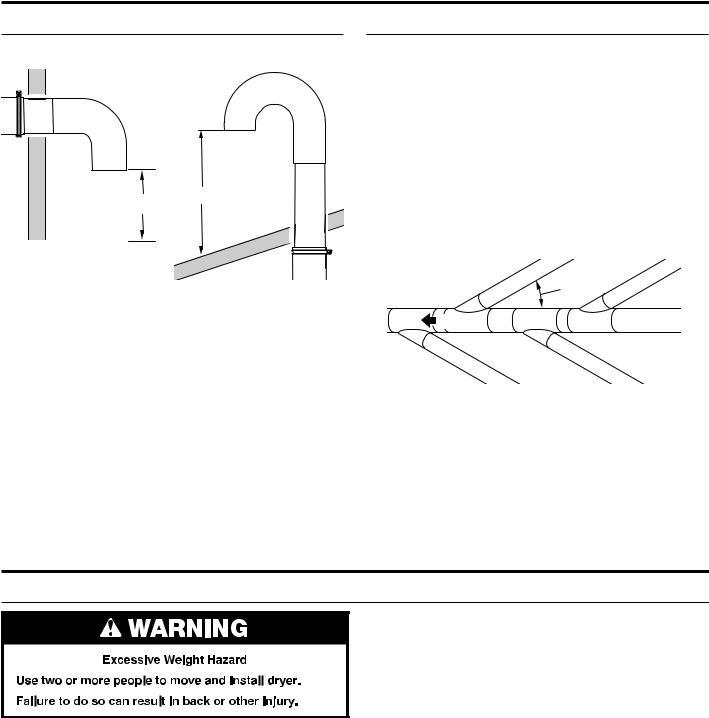
DRYER VENTING REQUIREMENTS
If an Exhaust Hood Cannot be Used
The outside end of main vent should have a sweep elbow directed downward.
24" min.
12" min. (610 mm)
(305 mm)*
*Minimum clearance above any accumulation of snow, ice, or debris such as leaves
If main vent travels vertically through the roof, rather than through wall, install a 180° sweep elbow on end of vent at least 2 ft. (610 mm) above surface of roof.
The opening in wall or roof shall have a diameter 1⁄2" (13 mm) larger than vent diameter. Vent should be centered in opening.
Do not install screening over end of vent for best performance.
Multiple Dryer Venting
A main vent can be used for venting a group of dryers. The main vent should be sized to remove 5663 l/min. (200 CFM) of air per dryer. Large-capacity lint screens of proper design may be used in main vent if checked and cleaned frequently. The room where the dryers are located should have make-up air equal to or greater than CFM of all the dryers in the room.
Back-draft Damper Kit, Part No. 3391910, is available from your distributor and should be installed in the vent of each dryer to keep exhausted air from returning into dryers and to keep exhaust in balance within main vent. Unobstructed return air openings are required.
Each vent should enter the main vent at an angle pointing in
the direction of the airflow. Vents entering from the opposite side should be staggered to reduce the exhausted air from interfering with the other vents.
 Airairflowow
Airairflowow
The maximum angle of each vent entering the main vent should be no more than 30°.
Keep air openings free of dry cleaning fluid fumes. Fumes create acids which, when drawn through the dryer heating units, can damage dryers and items being dried.
A clean-out cover should be located on the main vent for periodic cleaning of the vent system.
GAS SUPPLY CONNECTION
Make Gas Connection
1.Remove red cap from gas pipe on back of dryer.
2.Connect gas supply to dryer. Use a pipe thread compound approved for the type of gas supplied. If flexible metal tubing is used, be certain there are no kinks.
If necessary for service, open the toe panel. Use a putty knife to press on the toe panel locks located at the upper corners of the toe panel. Pull downward on the toe panel to open.
Toe panel is hinged at the bottom.
3.Open the shut-off valve in the gas supply line and make sure the dryer has its own gas supply opened.
4.Test all connections by brushing on an approved noncorrosive leak-detection solution. Bubbles will show a leak. Correct any leaks found.
15
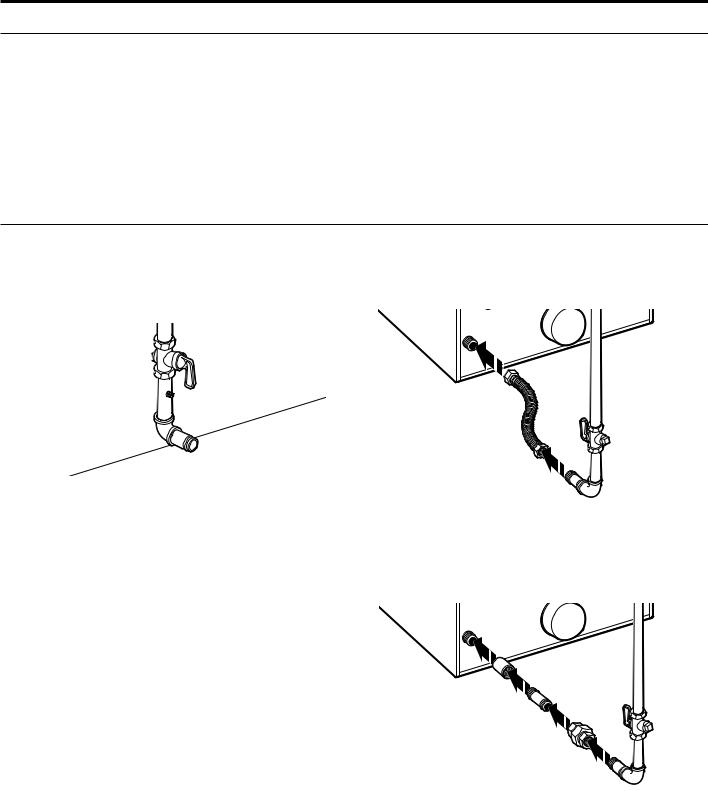
GAS SUPPLY CONNECTION
Type of Gas
This dryer is equipped for use with natural gas. It is design-certified by CSA International for LP (propane and butane) gases with appropriate conversion. No attempt shall be made to convert dryer from gas specified on serial/rating plate for use with a different gas without consulting the serving gas supplier. Conversion must be done by a qualified service technician.
Gas conversion kit part numbers are listed on gas valve burner base.
Gas Supply Line
Recommended Method
Provide a gas supply line of 1⁄2" (13 mm) rigid (IPS) pipe to dryer location. Pipe joint compounds that resist action of LP gas must be used. Do not use TEFLON®† tape. With LP gas, piping or tubing size can be 1⁄2" (13 mm) minimum. Usually, LP gas suppliers determine size and materials used in the system.
Gas Supply Pressure Testing
A 1/8" NPT minimum plugged tapping, accessible for gauge testing, must be installed immediately downstream of the installed shut-off valve to the dryer (as shown above). The dryer must
be disconnected from the gas supply piping system during any pressure testing of the system at test pressures in excess of 1/2" psig (352 kg/m2).
Alternate Method
The gas supply may also be connected using 3⁄8" (10 mm) approved copper or aluminum tubing. If the total length of the supply line is more than 20 ft. (6.1 m), larger tubing will be required.
If using natural gas, do not use copper tubing. Pipe joint compounds that resist action of type of gas supplied must be used.
Shut-off valve required
The supply line must be equipped with a manual shut-off valve installed within 6 ft. (1.8 m) of dryer in accordance with National Fuel Gas Code, ANSI Z223.1. This valve should be located in same room as dryer. It should be in a location that allows ease of opening and closing. Do not block access to shut-off valve.
In Canada, an individual manual shut-off valve must be installed in accordance with the B149 installation codes CAN/CGA B149.1 and CAN/CGA B149.2.
Flexible Metal Appliance Connector
It is recommended that a new flexible stainless steel gas line, design-certified by CSA International, be used for connecting the dryer to the gas supply line. (The gas pipe which extends through the lower rear of the dryer is provided with 3⁄8" male pipe thread.)
NOTE: Do not kink or damage the flexible stainless steel gas line when moving the dryer.
Rigid Pipe Connection
The rigid pipe connection requires a combination of pipe fittings to obtain an in-line connection to the dryer.
†®TEFLON is a registered trademark of E.I. Du Pont De Nemours and Company.
16

ELECTRIC DRYER ELECTRICAL CONNECTIONS (U.S.A. ONLY)
Strain Relief
Remove Terminal Block Cover |
Direct Wire Strain Relief |
|
1. Insert strain relief. |
2. Insert conduit into strain relief and tighten clamp.
Power Supply Cord Strain Relief 1. Insert strain relief.
2. Insert power cord into strain relief.
17
